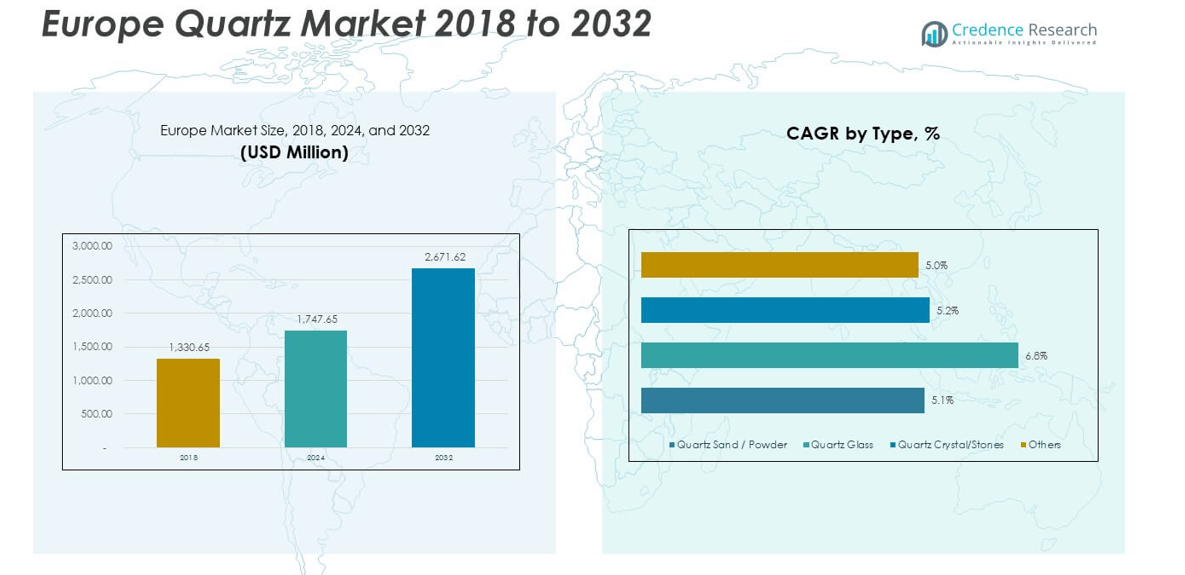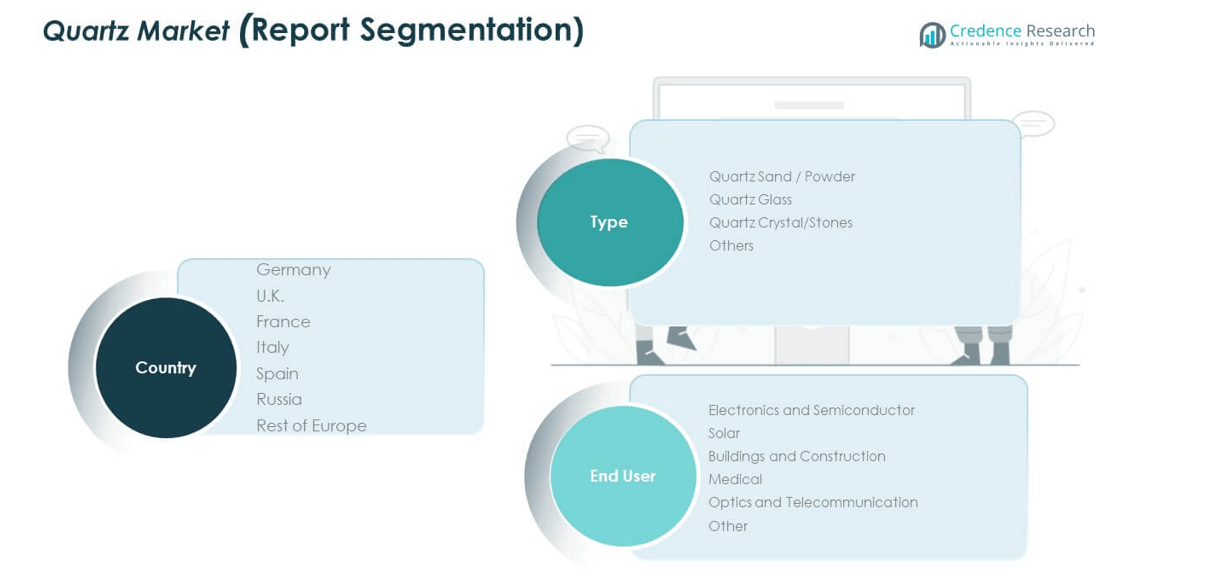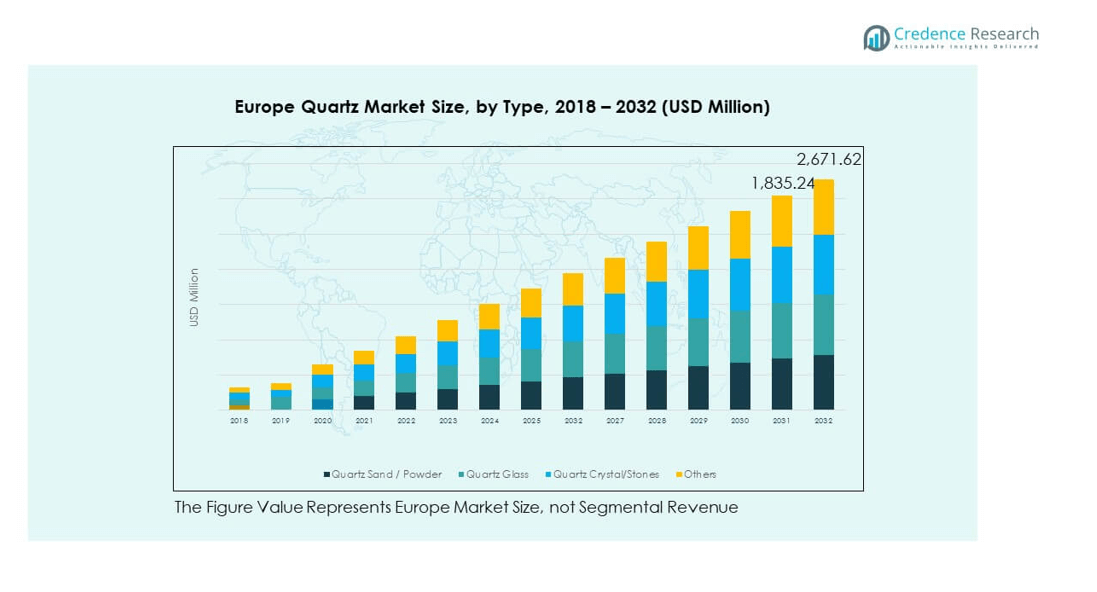Market Overview:
The Europe Quartz Market size was valued at USD 1,330.65 million in 2018 to USD 1,747.65 million in 2024 and is anticipated to reach USD 2,671.62 million by 2032, at a CAGR of 5.46% during the forecast period.
| REPORT ATTRIBUTE |
DETAILS |
| Historical Period |
2020-2023 |
| Base Year |
2024 |
| Forecast Period |
2025-2032 |
| Europe Quartz Market Size 2025 |
USD 1,747.65 million |
| Europe Quartz Market, CAGR |
5.46% |
| Europe Quartz Market Size 2032 |
USD 2,671.62 million |
The Europe Quartz Market is driven by rising demand across multiple industries, including electronics, construction, and semiconductors. Growth is supported by increasing adoption of high-purity quartz in photovoltaic applications, spurred by renewable energy initiatives across the region. Expanding demand from the automotive sector for advanced glass and composites further strengthens the market. Consumers are also driving growth through preferences for quartz-based countertops and decorative products in residential and commercial construction. Moreover, technological innovation in processing techniques is enhancing material performance, boosting its attractiveness across industries.
Regionally, Western Europe leads the market due to strong industrial infrastructure, established semiconductor manufacturing, and high construction activity in countries like Germany, France, and the UK. Northern Europe shows significant adoption of quartz in renewable energy projects, especially solar energy. Southern Europe demonstrates rising demand in residential construction and decorative applications. Eastern Europe is emerging as a growth area, fueled by increasing industrialization and expanding infrastructure projects. Together, these regional dynamics highlight both mature and emerging markets that shape the future growth path of quartz in Europe.

Market Insights:
- The Europe Quartz Market was valued at USD 1,330.65 million in 2018, reached USD 1,747.65 million in 2024, and is projected to reach USD 2,671.62 million by 2032, expanding at a CAGR of 5.46%.
- Western Europe held the largest share at 42% in 2024, driven by Germany, France, and the U.K. with strong industrial bases and renewable energy projects.
- Southern Europe accounted for 26% in 2024, supported by construction and solar growth in Italy and Spain, while Eastern and Northern Europe collectively held 32%, expanding through industrialization and renewable investments.
- From the chart, Quartz Sand / Powder led with 37% share in 2024, supported by wide use in electronics, glassmaking, and construction sectors.
- Quartz Glass followed with 29% share in 2024, fueled by semiconductor and photovoltaic demand, while Quartz Crystal/Stone and Others
Access crucial information at unmatched prices!
Request your sample report today & start making informed decisions powered by Credence Research Inc.!
Download Sample
Market Drivers:
Rising Demand for Quartz in Electronics and Semiconductor Manufacturing:
The Europe Quartz Market is experiencing growth driven by the electronics and semiconductor industries. Quartz is critical in producing high-purity wafers used for microchips and electronic components. Expanding consumer electronics adoption, driven by smartphones, tablets, and advanced computing, boosts the demand base. The region is witnessing strong investments in semiconductor plants, particularly in Germany and France. Quartz meets the industry’s need for stability, heat resistance, and durability. The renewable energy sector’s reliance on quartz-based photovoltaic components adds momentum. Strong European government policies supporting clean energy accelerate this trend further.
- For instance, Siltronic AG operates multiple production sites in Europe and provided silicon wafers for leading European semiconductor manufacturers throughout 2024, demonstrating its role as a key supplier of hyperpure quartz-based wafers to the semiconductor industry.
Growing Adoption of Quartz in Construction and Interior Applications:
The market is expanding due to quartz’s rising use in construction and decorative products. Quartz countertops, tiles, and flooring materials are becoming popular for residential and commercial spaces. Consumers prefer quartz for its durability, aesthetic appeal, and low maintenance features. Urbanization and real estate development across Europe strengthen construction demand. Countries such as the UK, Italy, and Spain show a clear preference for quartz in premium interior projects. It is widely used in modular kitchens, bathroom fittings, and hospitality spaces. This shift reinforces quartz as a long-term material choice across Europe.
- For instance, Caesarstone UK launched its latest collection of quartz surfaces in 2024, supplying high-quality, durable quartz worktops across Greater London and the South East for both residential and commercial projects.
Expanding Use of Quartz in Renewable Energy and Photovoltaic Applications:
Renewable energy projects across Europe are creating steady demand for quartz-based photovoltaic applications. Quartz glass plays a vital role in solar panel production due to its thermal and chemical properties. Countries such as Germany and Spain are expanding solar capacity, driving quartz demand. Quartz supports durability in harsh outdoor conditions, ensuring consistent solar panel performance. The European Union’s renewable energy targets encourage greater adoption of quartz in this sector. It provides material stability that enhances efficiency and reduces system maintenance costs. Rising solar installations are securing quartz’s long-term position in energy supply chains.
Increased Application of Quartz in Automotive and Industrial Sectors:
The automotive industry is creating new avenues for quartz adoption in Europe. Quartz-based glass and composites are essential in modern vehicle manufacturing. Demand is rising due to lightweight materials, improved fuel efficiency, and safety standards. Industrial applications in metallurgy and precision instruments also rely heavily on quartz. Growth in advanced manufacturing hubs across Germany and Central Europe supports this usage. It is used in specialized machinery, instruments, and optical devices. The expanding electric vehicle segment is further enhancing quartz demand in energy storage and charging solutions.
Market Trends:
Increasing Focus on Sustainable and Eco-Friendly Quartz Production:
Sustainability is becoming a central trend shaping the Europe Quartz Market. Manufacturers are adopting eco-friendly mining and processing practices to reduce emissions. Demand for recycled quartz products is also gaining traction in construction and interiors. European regulations are encouraging energy-efficient operations and sustainable material use. Companies are aligning with green building certifications by offering quartz products that meet environmental standards. This shift is building consumer trust and strengthening brand reputation across markets. Growing awareness of climate impact is ensuring sustainability becomes a long-term driver of competitiveness.
- For instance, Cosentino Group’s HybriQ® technology utilizes 99% reused water and 100% renewable electric energy in the manufacture of its Silestone quartz surfaces, achieving zero water waste and incorporating at least 20% recycled raw materials into production.
Technological Advancements in Quartz Processing and Customization:
Quartz manufacturers are focusing on innovation to enhance product performance and customization. New processing technologies enable higher purity levels for semiconductor and photovoltaic applications. Advanced cutting and finishing techniques deliver premium designs for interiors and architectural projects. Automation and digital solutions are improving efficiency across production plants. It is helping reduce costs while ensuring consistency in quality. Personalized quartz products with varied textures, colors, and finishes are gaining popularity. This trend reflects the growing consumer preference for unique and tailored materials.
- For instance, the Breton Genya CNC system, fully integrated in European fabrication shops throughout 2024, enables rapid, high-precision cutting of quartz slabs for countertops and architectural surfaces, with features such as a 5-axis cutting head, up to 700 mm blade diameter, auto-tool changing, and production capacity that allows a single operator to efficiently finish multiple parts per shift.
Rising Integration of Quartz in Smart and Connected Devices:
Quartz is finding increasing use in smart electronics and connected devices across Europe. The growth of IoT and wearable technologies requires precision quartz components. Quartz crystals support accurate timing and frequency control in these devices. Expansion of 5G networks across the region is driving demand for such components. Consumer adoption of smart home systems, fitness trackers, and medical devices strengthens this trend. The market is aligning with Europe’s focus on digital transformation and connectivity. Quartz plays a vital role in enabling performance and reliability in advanced electronics.
Growing Popularity of Quartz in Luxury and Premium Lifestyle Products:
Quartz is being embraced as a luxury material in lifestyle and consumer goods. Designers and manufacturers are using quartz in watches, jewelry, and decorative accessories. Its durability, clarity, and aesthetic appeal enhance product positioning in premium markets. The hospitality and retail sectors are also integrating quartz into high-end interiors. Consumer demand for exclusive, long-lasting, and elegant products is driving this adoption. Quartz offers versatility in design while maintaining structural strength. The trend reflects rising disposable income and preference for luxury lifestyles in Europe.

Market Challenges Analysis:
High Production Costs and Supply Chain Pressures:
The Europe Quartz Market faces challenges due to high production costs and supply chain constraints. Quartz extraction and purification require advanced technologies and energy-intensive processes. Dependence on imports of high-purity quartz raw materials adds cost pressures. Geopolitical issues and trade restrictions further complicate sourcing strategies. Volatility in energy prices across Europe impacts operating costs for manufacturers. It is forcing companies to balance between quality production and price competitiveness. Supply chain disruptions during global crises have also highlighted vulnerabilities. This challenge limits scalability and restricts small players from competing effectively.
Intense Competition and Substitutes in End-Use Industries:
Competition is rising due to the presence of global and regional players in the market. Each firm is focusing on innovation and customization to differentiate products. Alternatives such as natural stone, engineered composites, and ceramics pose substitute threats. The construction and interior industries often shift towards cheaper alternatives. This challenge pressures quartz producers to constantly innovate and justify premium pricing. In electronics, competition from emerging synthetic materials is also visible. The Europe Quartz Market must adapt by ensuring superior quality and reliability. Addressing competitive pressures requires sustained investment in R&D and customer engagement.
Market Opportunities:
Expansion of Renewable Energy and Solar Energy Projects:
The Europe Quartz Market holds strong opportunities in renewable energy growth. Quartz is essential for photovoltaic applications in solar panels. Europe’s push for clean energy under the Green Deal is accelerating solar adoption. Countries like Germany, Spain, and Italy are expanding solar capacity aggressively. This opens large-scale opportunities for quartz suppliers supporting panel production. It is reinforcing quartz as a long-term material in the energy value chain. Rising demand for sustainable power ensures stable growth prospects for the market.
Emergence of Eastern Europe as a High-Growth Market:
Eastern Europe is becoming a key growth frontier for the quartz industry. Industrialization and infrastructure projects are expanding demand for quartz-based applications. Residential construction is driving demand for decorative and interior quartz products. Governments in the region are investing heavily in energy and manufacturing capacity. Local quartz suppliers are emerging, but high-quality imports still dominate. The Europe Quartz Market can benefit from focusing on this rising demand cluster. It is creating opportunities for players to expand supply chains and regional partnerships.
Market Segmentation Analysis:
By Type
The Europe Quartz Market shows diverse demand across type categories. Quartz sand and powder dominate applications in construction, electronics, and glassmaking due to versatility and affordability. Quartz glass is growing with rising use in semiconductors, photovoltaic systems, and optical devices. Quartz crystal and stone maintain steady demand in luxury goods, watches, and decorative uses. Other forms support specialized applications in research, medical devices, and industrial processes. The type segmentation highlights quartz’s wide applicability across both industrial and consumer-focused sectors.
By End User
Electronics and semiconductors remain the largest end-user segment, supported by the region’s advanced manufacturing ecosystem. The solar industry is expanding demand for high-purity quartz in photovoltaic panels, aligning with Europe’s renewable energy goals. Buildings and construction continue to drive usage in interiors, countertops, and decorative products. The medical sector uses quartz for precision instruments, laboratory devices, and sterilization equipment. Optics and telecommunication benefit from quartz’s clarity and stability in fiber optics and lenses. Other smaller industries diversify consumption, securing long-term demand stability.
- For instance, Schott Pharma reported in Q2 2024 strong commercial production and delivery of prefillable glass and polymer syringes for hospitals and laboratories across Europe, enabled by new facilities inaugurated in Hungary, significantly enhancing its contribution to the medical device supply chain.

Segmentation:
By Type
- Quartz Sand / Powder
- Quartz Glass
- Quartz Crystal / Stone
- Others
By End User
- Electronics and Semiconductor
- Solar
- Buildings and Construction
- Medical
- Optics and Telecommunication
- Others
By Region / Country
- Europe (overall)
- Germany
- U.K.
- France
- Italy
- Spain
- Russia
- Rest of Europe
Regional Analysis:
Western Europe Leading with Strong Industrial and Construction Base
Western Europe dominates the Europe Quartz Market with a market share of nearly 42% in 2024. Germany, France, and the U.K. drive this dominance due to their established industrial base and strong semiconductor, construction, and renewable energy sectors. Germany remains a hub for electronics and automotive industries, supporting high demand for quartz glass and sand. France focuses on renewable energy, particularly solar projects, creating stable growth prospects. The U.K. contributes with demand from luxury interiors and advanced medical applications. It maintains a balanced presence across industrial and consumer segments, ensuring resilience in market expansion.
Southern Europe Growing Through Construction and Solar Expansion
Southern Europe accounts for around 26% of the market in 2024, driven by Italy and Spain. The region’s growth stems from rising demand in construction materials, decorative interiors, and modular housing projects. Italy leads with extensive use of quartz in countertops, tiles, and premium lifestyle products. Spain shows steady growth in photovoltaic installations, boosting demand for quartz in solar applications. Rising investments in hospitality and retail construction further enhance consumption patterns. It leverages growing urbanization trends to strengthen demand across residential and commercial spaces.
Eastern and Northern Europe Emerging as High-Growth Clusters
Eastern and Northern Europe collectively hold about 32% share in 2024, with Russia and Nordic countries contributing strongly. Russia is expanding industrial output and infrastructure, driving quartz usage in construction and electronics. Nordic nations prioritize renewable energy and advanced optics, boosting quartz demand in solar and telecommunications. Rest of Europe shows steady progress through urban development and adoption of quartz in medical instruments. Regional diversification ensures that growth is not concentrated only in mature markets. The Europe Quartz Market benefits from this balanced distribution, creating opportunities across developed and emerging economies.
Shape Your Report to Specific Countries or Regions & Enjoy 30% Off!
Key Player Analysis:
- Cambria
- MSI Q Quartz
- Nerostein
- Akrilika Holding Company
- Silestone
- Heraeus Holding
- HanStone Quartz
- Levantina Group
- Saint Gobain S.A
- Diresco
Competitive Analysis:
The Europe Quartz Market is characterized by strong competition between global leaders and regional specialists. Key players focus on product innovation, technological advancement, and sustainability to strengthen market share. Companies such as Saint-Gobain S.A., Heraeus Holding, Cambria, and Levantina Group dominate through broad portfolios and established distribution networks. Mid-sized firms compete by offering customized solutions in construction, electronics, and solar applications. Partnerships with industrial and renewable energy sectors are shaping future expansion strategies. It remains highly competitive, with differentiation centered on quality, purity levels, and application-specific performance.
Recent Developments:
- In February 2025, Cambria introduced four new quartz designs—Remington Brass™, Remington Steel™, Brighton™, and Berkshire Steel Satin Ridge™—at KBIS 2025, emphasizing dark aesthetics, textured finishes, and advanced backlit applications for luxury residential and commercial spaces.
- In September 2025, MSI launched seven new Q Quartz colors with bold veining and fresh hues for the European market, reflecting current interior trends and expanding design possibilities for kitchen countertops.
- In March 2025, Nerostein celebrated its 10th anniversary as a leading stone surface manufacturer in Northern Europe, marking its continuous growth, strengthening of partnerships, and innovative contributions to the quartz worktops market.
- In September 2025, Cosentino announced the launch of the new Le Chic Bohème by SilestoneXM collection in Europe, featuring four low silica colors produced using patented HybriQ+ technology (99% reused water, 100% renewable energy, and minimum 20% recycled content). This launch further strengthens the brand’s commitment to sustainability and design innovation.
Report Coverage:
The research report offers an in-depth analysis based on type, end user, and region. It details leading market players, providing an overview of their business, product offerings, investments, revenue streams, and key applications. Additionally, the report includes insights into the competitive environment, SWOT analysis, current market trends, as well as the primary drivers and constraints. Furthermore, it discusses various factors that have driven market expansion in recent years. The report also explores market dynamics, regulatory scenarios, and technological advancements that are shaping the industry. It assesses the impact of external factors and global economic changes on market growth. Lastly, it provides strategic recommendations for new entrants and established companies to navigate the complexities of the market.
Future Outlook:
- Rising demand in semiconductor manufacturing will support quartz glass consumption.
- Growth in renewable energy projects will expand photovoltaic quartz applications.
- Construction and interior design markets will sustain demand for quartz stone.
- Medical devices and precision instruments will create niche opportunities.
- Adoption of advanced optical technologies will drive growth in telecommunications.
- Eastern Europe will emerge as a promising region for quartz expansion.
- Sustainable production methods will influence competitive positioning.
- Strategic mergers and acquisitions will reshape supply chains.
- Premium lifestyle applications will fuel demand for decorative quartz.
- Technological advances in processing will enhance product performance and quality.










